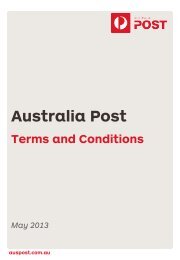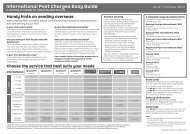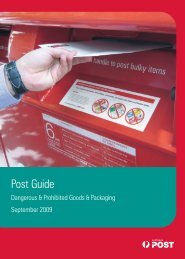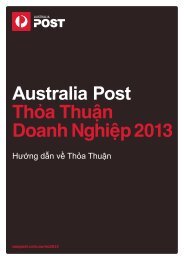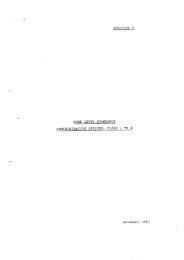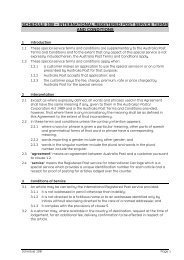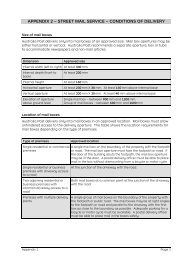stamp bulletin stamp bulletin - Australia Post Shop
stamp bulletin stamp bulletin - Australia Post Shop
stamp bulletin stamp bulletin - Australia Post Shop
Create successful ePaper yourself
Turn your PDF publications into a flip-book with our unique Google optimized e-Paper software.
<strong>Australia</strong>n Territories Collection 2003<br />
2003<br />
THE AUSTRALIAN TERRITORIES COLLECTION<br />
COLLECTION OF STAMPS FOR THREE EXTERNAL AUSTRALIAN TERRITORIES<br />
COCOS (KEELING) ISLANDS<br />
CHRISTMAS ISLAND<br />
AUSTRALIAN ANTARCTIC TERRITORY<br />
2003 <strong>Australia</strong>n Territories issues<br />
January Christmas Island, Lunar New Year, Year<br />
of the Goat<br />
April AAT Antarctic Ships<br />
June Cocos (Keeling Islands) Shoreline birds<br />
October Christmas Island Christmas<br />
The <strong>stamp</strong> issues of three of <strong>Australia</strong>’s<br />
external Territories – Cocos (Keeling) Islands,<br />
Christmas Island and the <strong>Australia</strong>n Antarctic<br />
Territory – come together in <strong>Australia</strong> <strong>Post</strong>’s<br />
<strong>Australia</strong>n Territories Collection 2003 .<br />
Featured in the collection are distinctive<br />
designs ranging from Luis Chiang’s dazzling<br />
Christmas Island Lunar New Year, to Peter<br />
Gouldthorpe’s bold AAT Antarctic Ships, Kevin<br />
Stead’s lovely Cocos (Keeling) Island Shoreline<br />
Birds and Bill Wood’s cheeky Christmas Island<br />
Christmas <strong>stamp</strong>s.<br />
The collection includes 26 <strong>stamp</strong>s from<br />
four different issues including the Lunar New<br />
Year Zodiac sheetlet incorporating the Year of<br />
the Goat miniature sheet design and 12 zodiac<br />
<strong>stamp</strong>s embellished in gold foil.<br />
The <strong>stamp</strong>s in this collection have a face<br />
value of $12.40. With a price of just $19.95 it<br />
20<br />
Koleksi Wilayah <strong>Australia</strong><br />
SHORELINE BIRDS<br />
Burung Garisan Pesisir<br />
COCOS (KEELING) ISLANDS<br />
Kepulauan Kokos (Keeling)<br />
When Charles Darwin visited the southern atoll of the Cocos (Keeling)<br />
Islands in 1836, he commented on the ‘immense number’ of marine birds.<br />
Today this atoll is almost devoid of bird life. Coconut plantation harvesting<br />
has destroyed the nesting habitats of most birds and introduced pests have<br />
succeeded in depleting species further. The northern atoll, North Keeling<br />
Island, which has not been inhabited for any continuous period, is still in<br />
its natural state, one of the few remaining untouched tropical islands in the<br />
Indian Ocean.<br />
North Keeling Island (proclaimed Pulu Keeling National Park in 1995) has<br />
a worldwide reputation as a seabird rookery. It is also a staging point for<br />
several species of migratory waders that feed on the numerous crabs and<br />
other small crustaceans that dominate the shoreline ecology. None of these<br />
birds is endemic to the Cocos (Keeling) Islands. The Eastern Reef Egret<br />
(Egretta sacra) and the Sooty Tern (Sterna fuscata) nest on North Keeling<br />
Island while the Ruddy Turnstone (Arenaria interpres) and the Whimbrel<br />
(Numenius phaeopus) are non-breeding migratory visitors to the island. The<br />
continuous scene across the <strong>stamp</strong>s represents the four birds on the shore of<br />
the lagoon of North Keeling Island.<br />
Eastern Reef Egrets are usually solitary, and stalk prey in a hunched posture<br />
in rock pools or coral reefs. They sometimes stand and wait, but more often<br />
walk quickly through the shallows, alert for fish, crustaceans or insects. The<br />
Eastern Reef Egret on the <strong>stamp</strong> is represented searching for prey in the<br />
shallows. Two Sooty Terns fly in the background.<br />
The black and white Sooty Tern’s range is the world’s vast tropical and<br />
subtropical oceans. At sea it lives in the air, rarely settling on the water;<br />
indeed, it possibly sleeps on the wing. Over the ocean Sooty Terns keep in<br />
flocks to feed on mainly squid, fish and crustaceans. Unlike other terns they<br />
do not dive for food but instead scoop it from or just below the water’s<br />
surface. Feeding is done on the wing, skimming, dipping and wheeling<br />
gracefully over the water.<br />
The Ruddy Turnstone is named for its habit of flipping over stones and shells<br />
in search of crustaceans and molluscs. This small, animated bird breeds in<br />
the far north of the Northern Hemisphere from June to July, and makes a<br />
long yearly migration to southern continents. When feeding, these shorefrequenting<br />
waders are almost constantly on the move. They dash about,<br />
snatching at food as it becomes exposed, breaking open barnacles with<br />
several rapid blows of the closed bill, prising limpets off rocks, and opening<br />
mussels with vigorous chiselling thrusts. Ruddy Turnstones frequent beaches<br />
where shingle and masses of seaweed are mixed with stretches of sand.<br />
Like the Ruddy Turnstone, the Whimbrel is a non-breeding migrant to North<br />
Keeling Island. It breeds in the far north near the Arctic Circle, migrating<br />
during the winter months to the warmer southern continents. A medium<br />
sized curlew, it forages on beaches and reefs by probing for worms or<br />
molluscs in mud or sand and picking up crustaceans and insects among<br />
rocks, coral and seaweed.<br />
Active and wary,<br />
Whimbrels occur on<br />
North Keeling Island<br />
from September to<br />
May either in small<br />
flocks or as solitary birds.<br />
Date of issue: 17 June 2003<br />
Illustration: Kevin Stead, Adelaide<br />
CHRISTMAS ISLAND<br />
Pulau Krismas<br />
The goat (sometimes translated as ram or sheep) is the eighth sign in<br />
the Chinese zodiac. In Chinese tradition, the goat is the most tranquil<br />
of the twelve Chinese animals and symbolises beauty and good fortune.<br />
Those born in the year of the Goat are said to be easy-going, amiable,<br />
gentle and compassionate, their sense of fun and humour making them<br />
popular company. At the same time they can be pessimistic, indecisive and<br />
dependent. Family bonds are important to them. Goat years in the 20th<br />
century were 1907, 1919, 1931, 1943, 1955, 1967, 1979 and 1991.<br />
The miniature sheet design is based on one of the many Chinese folk tales<br />
involving goats. Five immortals arrived at the city of Guangzhou riding<br />
divine goats of different colours. Each carried an ear of grain, which was<br />
given to the people to teach them how to cultivate the land. When the five<br />
immortals departed the goats turned into rocks. Today the five goat statue<br />
is the symbol of Guangzhou city.<br />
CHRISTMAS ISLAND<br />
Pulau Krismas<br />
31 dd October Month YYYY 2003<br />
Issue date: 7 January 2003<br />
Design: Luis Chiang, Melbourne<br />
The warm waters surrounding Christmas Island are a world-renowned<br />
destination for divers, who often encounter Whalesharks, the world’s largest<br />
fish. These harmless plankton-feeding sharks can grow up to an impressive<br />
18 metres in length, and divers are sometimes able to catch a short ride on<br />
the dorsal fin.<br />
Santa is shown approaching the island riding on a friendly whaleshark<br />
and escorted by Red-footed Booby birds. The distinctive limestone cliffs of<br />
Christmas Island are visible in the background. On shore, Santa distributes<br />
gifts to some of the island’s ubiquitous Red Crabs. Red crabs are the dominant<br />
wildlife, with an extraordinary 120 million estimated to live on Christmas<br />
Island. The whaleshark swims back to sea and the red-footed booby birds are<br />
now carolling from a tree branch. Santa is seated on a Green Turtle, one of<br />
several turtle species found around the Christmas Island coastline.<br />
Issue date: 31 October 2003<br />
Illustration: Bill Wood, Melbourne<br />
YEAR OF THE GOAT<br />
Tahun Kambing<br />
CHRISTMAS<br />
Krismas<br />
is excellent value. The <strong>Australia</strong>n Territories<br />
Collection 2003 makes an ideal gift and is also<br />
an affordable introduction to the hobby of<br />
<strong>stamp</strong> collecting.<br />
The Territories Collection includes a<br />
presentation folder designed to complement<br />
the Annual Collection of <strong>Australia</strong>n Stamps.<br />
For storage, the presentation folder fi ts in the<br />
Collector’s Choice 3 Ring Binder ($17.95)<br />
The <strong>Australia</strong>n Territories Collection 2003<br />
will be available in retail outlets and by mail<br />
order from the <strong>Australia</strong>n Philatelic Bureau<br />
from 31 October 2003.<br />
Mail order codes<br />
1386194 <strong>Australia</strong>n Territories Collection 2003 .... $19.95<br />
0903269 Collector’s Choice (3-ring) Binder .......... $17.95




